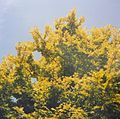| Ulmus 'Louis van Houtte' | |
|---|---|
 'Louis van Houtte' in Christchurch Botanic Gardens, New Zealand | |
| Genus | Ulmus |
| Cultivar | 'Louis van Houtte' |
| Origin | Belgium |
Ulmus 'Louis van Houtte' (Syn. Ulmus 'Vanhouttei') is believed to have been first cultivated in Ghent, Belgium circa 1863. [1] [2] It was first mentioned by Franz Deegen in 1886. [3] [4] It was once thought a cultivar of English Elm Ulmus minor 'Atinia', though this derivation has long been questioned; W. J. Bean called it "an elm of uncertain status". [5] Its dissimilarity from the type and its Belgian provenance make the 'Atinia' attribution unlikely. Fontaine (1968) considered it probably a form of U. × hollandica. [6]
Contents
- Description
- Pests and diseases
- Cultivation
- Notable trees
- Synonymy
- Accessions
- North America
- Europe
- Australasia
- Nurseries
- Europe 2
- North America 2
- Notes
- References
The cultivar is named for the Belgian horticulturist and plant collector Louis Benoit van Houtte, 1810–1876.









